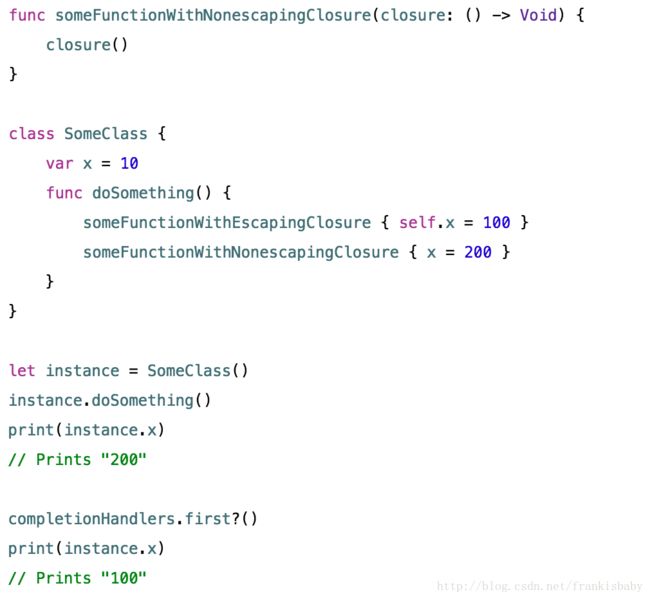- Swift教程17-淡化MVC,使用MVVM框架开发轻巧便于维护的iOS app
BoolBear
iosswiftmvvm
MVVM是微软提出一种移动开发框架,旨在针对传统的MVC框架,解决传统的MVC框架的控制器的臃肿问题.M:Model模型,也就是数据模型;比如一条微博,对应的所有字段合成一条微博整体,这个整体就是ModelV:View视图,只用来显示的视图,如iOS的UIView,Cell;当然在iOS中Storyboard中,view总是和控制器关联,这并不是严格的view如果我们纯手写代码定义一个view那么
- React Native 0.77发布,新样式特性,Android 16KB页面支持,Swift模板
wayne214
reactnativeandroidswift
ReactNative0.77版本发布:新特性、改进与迁移说明2025年1月21日,ReactNative0.77正式发布,此版本带来诸多新特性、对Android的支持增强、社区模板更新以及一些重要变更。一、新特性亮点(一)CSS新特性助力布局、尺寸与混合效果display:contents简化布局逻辑:该属性使元素自身在布局结构中“消失”,但子元素仍正常渲染,就像直接作为父元素的子元素一样。在构
- 主流编程语言的优劣分析及学习建议
我的青春不太冷
学习java开发语言android经验分享笔记
不同语言的特性主流编程语言的优劣分析及学习建议1.Python优点缺点学习建议适用于哪些人?2.JavaScript优点缺点学习建议适用于哪些人?3.Java优点缺点学习建议适用于哪些人?4.C++优点缺点学习建议适用于哪些人?5.Swift优点缺点学习建议适用于哪些人?结论主流编程语言的优劣分析及学习建议对于年轻人或者即将开始编程学习的人来说,选择一门合适的编程语言至关重要。不同的编程语言有各自
- 【二叉树】二叉树剪枝
豪冷啊
算法
0x00题目给你二叉树的根结点root此外树的每个结点的值要么是0,要么是1返回移除了所有不包含1的子树的原二叉树节点node的子树为node本身加上所有node的后代0x01思路叶子节点值为0时,去掉某个节点的如果要去掉则左子树的值全为0右子树的值是全为0再加上节点本身的值也是0反过来讲,也就是以某个节点为根的子树只要存在值为1的节点则这棵子树不用删除0x02解法语言:Swift树节点:Tree
- CopilotForXcode: 为Xcode带来AI辅助编程的强大扩展
2401_87189860
xcode人工智能macos
CopilotForXcode:为Xcode带来AI辅助编程的强大扩展在人工智能快速发展的今天,AI辅助编程工具正在成为开发者提升效率的重要助手。对于使用Xcode进行iOS、macOS等Apple平台开发的Swift程序员来说,一款名为CopilotForXcode的扩展正在受到越来越多的关注。本文将详细介绍CopilotForXcode的主要功能、安装配置过程以及使用技巧,帮助开发者充分利用这
- 【前沿聚焦】机器学习的未来版图:从自动化到隐私保护的技术突破
网罗开发
人工智能AI大模型机器学习人工智能
网罗开发(小红书、快手、视频号同名) 大家好,我是展菲,目前在上市企业从事人工智能项目研发管理工作,平时热衷于分享各种编程领域的软硬技能知识以及前沿技术,包括iOS、前端、HarmonyOS、Java、Python等方向。在移动端开发、鸿蒙开发、物联网、嵌入式、云原生、开源等领域有深厚造诣。图书作者:《ESP32-C3物联网工程开发实战》图书作者:《SwiftUI入门,进阶与实战》超级个体:CO
- LeetCode - #195 Swift 实现打印文件中的第十行
网罗开发
Swiftvue.jsleetcodeswift
网罗开发(小红书、快手、视频号同名) 大家好,我是展菲,目前在上市企业从事人工智能项目研发管理工作,平时热衷于分享各种编程领域的软硬技能知识以及前沿技术,包括iOS、前端、HarmonyOS、Java、Python等方向。在移动端开发、鸿蒙开发、物联网、嵌入式、云原生、开源等领域有深厚造诣。图书作者:《ESP32-C3物联网工程开发实战》图书作者:《SwiftUI入门,进阶与实战》超级个体:CO
- 部署通义千问Qwen模型时,遇到Flash-Attention2装不上的问题
清米Dummy
python
参考Qwen2-VL最佳实践—swift2.5.0.dev0文档我不去装什么Flash-Attention2,说是要编译好几个小时,然后我这边一直报错。直接从头开始说我的部署方式,最后可以实现图片描述:1.从“通义千问2-VL-7B-Instruct·模型库”下载模型到本地2.按照参考的文档里,完成如下操作:gitclonehttps://github.com/modelscope/ms-swif
- 深度学习探索:ChatGPT数据分析精髓 & 梯度下降优化方法深度剖析
网罗开发
AI大模型人工智能深度学习chatgpt数据分析
网罗开发(小红书、快手、视频号同名) 大家好,我是展菲,目前在上市企业从事人工智能项目研发管理工作,平时热衷于分享各种编程领域的软硬技能知识以及前沿技术,包括iOS、前端、HarmonyOS、Java、Python等方向。在移动端开发、鸿蒙开发、物联网、嵌入式、云原生、开源等领域有深厚造诣。图书作者:《ESP32-C3物联网工程开发实战》图书作者:《SwiftUI入门,进阶与实战》超级个体:CO
- flutter引入高德地图_Flutter接入高德地图后运行报错
耀答案
flutter引入高德地图
1、flutter开发接入高德地图包后运行报下面错误信息fatalerror:'simple_permissions/simple_permissions-Swift.h'filenotfound运行在iPhone手机时出现以下错误信息:===BUILDTARGETurl_launcherOFPROJECTPodsWITHCONFIGURATIONDebug===/Users/bobo/flutt
- iOS swift 后台运行应用尝试失败
taopi2024
iOSiosswiftxcode
最近需要制作一个能够后台长期运行的移动应用。该应用需要调用摄像头周期性捕获数据,然后对数据处理过后,实时反馈结果。支持android和ios平台。主要有下面几点:1、摄像头实时捕获2、能够适配多款不同机型的处理算法3、能在后台以服务形式常驻运行,不影响用户使用其他应用4、根据数据处理结果,给用户提醒,通常用户这时在使用其他应用在安卓平台上,已经通过多款不同型号的手机,验证了方案与算法,包括用户易用
- Swift 周报 第二十八期
Swift社区
Apple周刊swift开发语言ios
文章目录前言新闻和社区外媒:iPhone的平均售价直逼1000美元创历史新高分析师:iPhone需求良好,苹果股价还能涨22%准备好迎接即将在5月9日推出的增强全球定价机制提案通过的提案正在审查的提案Swift论坛推荐博文话题讨论关于我们前言本期是Swift编辑组自主整理周报的第十九期,每个模块已初步成型。各位读者如果有好的提议,欢迎在文末留言。欢迎投稿或推荐内容。目前计划每两周周一发布,欢迎志同
- 融云IM干货丨在SwiftUI中集成IMKit,集成IMKit的基本步骤有哪些
融云im即时通讯
创建项目:打开Xcode并创建一个新的Swift项目。RongCloudIM/IMKit支持Swift,确保你的项目设置为使用Swift语言。安装IMKit:你可以通过CocoaPods来安装iOS版本的IMKit(含UISDK)。在Podfile中添加以下内容:rubypod'RongCloudIM/IMKit','~>x.y.z'然后,在终端中运行以下命令:podrepoupdatepodin
- 探秘BFKit-Swift:开发加速神器
纪亚钧
探秘BFKit-Swift:开发加速神器BFKit-SwiftBFKit-Swiftisacollectionofusefulclasses,structsandextensionstodevelopAppsfaster.项目地址:https://gitcode.com/gh_mirrors/bf/BFKit-Swift在快速发展的移动应用领域,效率与质量是开发者永恒的追求。今天,让我们一起走进B
- 【分布式日志篇】从工具选型到实战部署:全面解析日志采集与管理路径
网罗开发
人工智能实战java集springboot人工智能分布式
网罗开发(小红书、快手、视频号同名) 大家好,我是展菲,目前在上市企业从事人工智能项目研发管理工作,平时热衷于分享各种编程领域的软硬技能知识以及前沿技术,包括iOS、前端、HarmonyOS、Java、Python等方向。在移动端开发、鸿蒙开发、物联网、嵌入式、云原生、开源等领域有深厚造诣。图书作者:《ESP32-C3物联网工程开发实战》图书作者:《SwiftUI入门,进阶与实战》超级个体:CO
- 【AI日志分析】基于机器学习的异常检测:告别传统规则的智能进阶
网罗开发
AI大模型人工智能机器学习
网罗开发(小红书、快手、视频号同名) 大家好,我是展菲,目前在上市企业从事人工智能项目研发管理工作,平时热衷于分享各种编程领域的软硬技能知识以及前沿技术,包括iOS、前端、HarmonyOS、Java、Python等方向。在移动端开发、鸿蒙开发、物联网、嵌入式、云原生、开源等领域有深厚造诣。图书作者:《ESP32-C3物联网工程开发实战》图书作者:《SwiftUI入门,进阶与实战》超级个体:CO
- SwiftUI 2.0实现动态粘性页脚动画指南
一曲歌长安
本文还有配套的精品资源,点击获取简介:在SwiftUI2.0中创建类似Medium.com的动态粘性页脚,涉及视图构建、环境值跟踪、自定义组件设计、动画实现以及响应式布局,以增强用户体验并提升应用程序的互动性。开发者将学习到如何通过滚动位置的变化来控制页脚的透明度和尺寸,并通过动画使交互更为流畅自然。1.SwiftUI核心概念理解SwiftUI是苹果公司推出的一套声明式UI框架,它使得开发者可以使
- 【多模态 AI】从跨模态学习到生成革命:文本、图像与音频的深度交融
网罗开发
人工智能AI大模型机器学习人工智能AIGC
网罗开发(小红书、快手、视频号同名) 大家好,我是展菲,目前在上市企业从事人工智能项目研发管理工作,平时热衷于分享各种编程领域的软硬技能知识以及前沿技术,包括iOS、前端、HarmonyOS、Java、Python等方向。在移动端开发、鸿蒙开发、物联网、嵌入式、云原生、开源等领域有深厚造诣。图书作者:《ESP32-C3物联网工程开发实战》图书作者:《SwiftUI入门,进阶与实战》超级个体:CO
- Swift 并发
xiaoxiaobukuang
Swift教程V5.5swift服务器开发语言ios
并发一、定义和调用异步函数二、异步序列三、并行的调用异步方法四、任务和任务组1、非结构化并发2、任务取消五、ActorsSwift对于结构化的编写异步和并行代码有着原生的支持。异步代码可以被挂起并在之后继续执行,同一时间只能有一段代码被执行。代码支持挂起和继续执行,就可以在执行耗时很长的任务时抽空执行一些快速的操作,比如在下载文件、解析文件的过程中更新UI。并行代码指的是多段代码同时执行;比如一个
- React Native 0.77发布,新样式特性,Android 16KB页面支持,Swift模板
ReactNative0.77版本发布:新特性、改进与迁移说明2025年1月21日,ReactNative0.77正式发布,此版本带来诸多新特性、对Android的支持增强、社区模板更新以及一些重要变更。一、新特性亮点(一)CSS新特性助力布局、尺寸与混合效果display:contents简化布局逻辑:该属性使元素自身在布局结构中“消失”,但子元素仍正常渲染,就像直接作为父元素的子元素一样。在构
- 反转字符串中的单词 II:Swift 实现与详解
网罗开发
Swiftvue.js
网罗开发(小红书、快手、视频号同名) 大家好,我是展菲,目前在上市企业从事人工智能项目研发管理工作,平时热衷于分享各种编程领域的软硬技能知识以及前沿技术,包括iOS、前端、HarmonyOS、Java、Python等方向。在移动端开发、鸿蒙开发、物联网、嵌入式、云原生、开源等领域有深厚造诣。图书作者:《ESP32-C3物联网工程开发实战》图书作者:《SwiftUI入门,进阶与实战》超级个体:CO
- swift withCheckedContinuation相关使用
书弋江山
swift开发语言ios
```css```cssclasstest112:NSObject{enumMErr:Error{caseserverError(String)}/*withCheckedContinuation是Swift并发模型中的一个重要工具,它允许你将异步操作转换为一个暂停的函数,直到你手动恢复它。它在将传统的回调式异步代码转换为async/await风格时非常有用确保调用continuation.res
- Swift语言的学习路线
2501_90183952
包罗万象golang开发语言后端
Swift语言的学习路线引言在现代程序开发中,Swift语言逐渐成为了移动应用程序开发的重要工具,尤其是在iOS和macOS平台上。自2014年发布以来,Swift以其易读性和强大的功能,受到越来越多开发者的青睐。对于初学者而言,选择一条清晰的学习路线是学习Swift的关键。本文将为你提供一份详细的Swift语言学习路线图,帮助你从入门到精通,逐步掌握Swift的应用与开发技巧。1.学习Swift
- Swift语言的网络编程
BinaryBardC
包罗万象golang开发语言后端
Swift语言的网络编程引言在当今这个信息技术飞速发展的时代,网络编程已经成为软件开发中不可或缺的一部分。Swift语言作为苹果公司推出的一种现代编程语言,不仅在iOS和macOS应用开发中得到了广泛应用,也在网络编程领域展示了其强大的能力。本文将深入探讨Swift语言的网络编程,涵盖网络请求、解析请求数据以及处理响应和错误等多个方面,希望能为读者提供一个全面的理解。Swift语言概述Swift是
- Swift语言的多线程编程
Code侠客行
包罗万象golang开发语言后端
Swift语言的多线程编程在现代软件开发中,多线程编程是提高应用性能和响应速度的重要手段。尤其是在iOS和macOS开发中,由于用户界面(UI)的交互性和复杂性,合理利用多线程可以极大地提升用户体验。本文将深入探讨Swift语言中的多线程编程机制,包括GCD(GrandCentralDispatch)、NSOperation、线程的基本概念及其使用场景。一、什么是多线程多线程是一种程序设计理念,通
- Swift语言的函数实现
2501_90183952
包罗万象golang开发语言后端
Swift语言函数实现详解引言Swift是一种强类型、泛型编程的现代编程语言,广泛应用于iOS和macOS开发。函数是Swift编程中的基本构建块之一,通过函数可以将代码进行模块化,实现重用性和可读性。本篇文章将系统地介绍Swift中的函数,包括其定义、参数、返回值、闭包和高阶函数等,实现一些实用的示例,帮助读者更好地理解和掌握Swift的函数特性。一、函数的基本概念函数是执行特定任务的一段代码,
- iOS 网络请求: Alamofire 结合 ObjectMapper 实现自动解析
胖虎1
开发经验分享iosAlamofireObjectMapper网络请求自动解析数据自动解析模型
引言在iOS开发中,网络请求是常见且致其重要的功能之一。从获取资料到上传数据,出色的网络请求框架能夠大大提升开发效率。Alamofire是一个极具人气的Swift网络请求框架,提供了便据的API以完成网络请求和响应处理。它支持多种请求类型,如GET和POST,并且给予您便据的带容处理过滤器和返回数据解析的功能。ObjectMapper是一个强大的Swift数据映射工具,使用其提供的Mappable
- ios storekit_在iOS 14中的应用购买和storekit中
weixin_26745865
iospython
iosstorekitMuchofthebuzzatWWDC2020wasgivenovertoSwiftUI2.0andARKit,soyoushouldforgiveyourselfformissingaseismicchangetotheStoreKitframework—achangethatwillmakeyourlifeasanappdeveloperfareasier.WWDC202
- Objective-C语言的学习路线
AI向前看
包罗万象golang开发语言后端
Objective-C语言的学习路线在程序开发的历史长河中,Objective-C作为一种继承自C语言与Smalltalk的编程语言,扮演着重要的角色。虽然随着Swift语言的出现,Objective-C的使用有所减少,但它依然是iOS和macOS应用开发的重要基础,许多现有的大型应用程序仍然在使用它。因此,学习Objective-C,不仅能帮助我们理解更古老的代码库,还能加深我们对面向对象编程的
- Objective-C语言的软件开发工具
2501_90183910
包罗万象golang开发语言后端
Objective-C语言软件开发工具的现状与发展引言在软件开发的世界中,编程语言的选择对项目的成功与否至关重要。Objective-C作为Apple公司推出的一种编程语言,自1980年代以来一直在macOS和iOS的开发中占据着重要地位。尽管Swift的出现为开发者提供了更多的选择,但Objective-C仍然在某些领域保持着其不可替代的优势。本文将深入探讨Objective-C语言的软件开发工
- Enum用法
不懂事的小屁孩
enum
以前的时候知道enum,但是真心不怎么用,在实际开发中,经常会用到以下代码:
protected final static String XJ = "XJ";
protected final static String YHK = "YHK";
protected final static String PQ = "PQ";
- 【Spark九十七】RDD API之aggregateByKey
bit1129
spark
1. aggregateByKey的运行机制
/**
* Aggregate the values of each key, using given combine functions and a neutral "zero value".
* This function can return a different result type
- hive创建表是报错: Specified key was too long; max key length is 767 bytes
daizj
hive
今天在hive客户端创建表时报错,具体操作如下
hive> create table test2(id string);
FAILED: Execution Error, return code 1 from org.apache.hadoop.hive.ql.exec.DDLTask. MetaException(message:javax.jdo.JDODataSto
- Map 与 JavaBean之间的转换
周凡杨
java自省转换反射
最近项目里需要一个工具类,它的功能是传入一个Map后可以返回一个JavaBean对象。很喜欢写这样的Java服务,首先我想到的是要通过Java 的反射去实现匿名类的方法调用,这样才可以把Map里的值set 到JavaBean里。其实这里用Java的自省会更方便,下面两个方法就是一个通过反射,一个通过自省来实现本功能。
1:JavaBean类
1 &nb
- java连接ftp下载
g21121
java
有的时候需要用到java连接ftp服务器下载,上传一些操作,下面写了一个小例子。
/** ftp服务器地址 */
private String ftpHost;
/** ftp服务器用户名 */
private String ftpName;
/** ftp服务器密码 */
private String ftpPass;
/** ftp根目录 */
private String f
- web报表工具FineReport使用中遇到的常见报错及解决办法(二)
老A不折腾
finereportweb报表java报表总结
抛砖引玉,希望大家能把自己整理的问题及解决方法晾出来,Mark一下,利人利己。
出现问题先搜一下文档上有没有,再看看度娘有没有,再看看论坛有没有。有报错要看日志。下面简单罗列下常见的问题,大多文档上都有提到的。
1、没有返回数据集:
在存储过程中的操作语句之前加上set nocount on 或者在数据集exec调用存储过程的前面加上这句。当S
- linux 系统cpu 内存等信息查看
墙头上一根草
cpu内存liunx
1 查看CPU
1.1 查看CPU个数
# cat /proc/cpuinfo | grep "physical id" | uniq | wc -l
2
**uniq命令:删除重复行;wc –l命令:统计行数**
1.2 查看CPU核数
# cat /proc/cpuinfo | grep "cpu cores" | u
- Spring中的AOP
aijuans
springAOP
Spring中的AOP
Written by Tony Jiang @ 2012-1-18 (转)何为AOP
AOP,面向切面编程。
在不改动代码的前提下,灵活的在现有代码的执行顺序前后,添加进新规机能。
来一个简单的Sample:
目标类:
[java]
view plain
copy
print
?
package&nb
- placeholder(HTML 5) IE 兼容插件
alxw4616
JavaScriptjquery jQuery插件
placeholder 这个属性被越来越频繁的使用.
但为做HTML 5 特性IE没能实现这东西.
以下的jQuery插件就是用来在IE上实现该属性的.
/**
* [placeholder(HTML 5) IE 实现.IE9以下通过测试.]
* v 1.0 by oTwo 2014年7月31日 11:45:29
*/
$.fn.placeholder = function
- Object类,值域,泛型等总结(适合有基础的人看)
百合不是茶
泛型的继承和通配符变量的值域Object类转换
java的作用域在编程的时候经常会遇到,而我经常会搞不清楚这个
问题,所以在家的这几天回忆一下过去不知道的每个小知识点
变量的值域;
package 基础;
/**
* 作用域的范围
*
* @author Administrator
*
*/
public class zuoyongyu {
public static vo
- JDK1.5 Condition接口
bijian1013
javathreadConditionjava多线程
Condition 将 Object 监视器方法(wait、notify和 notifyAll)分解成截然不同的对象,以便通过将这些对象与任意 Lock 实现组合使用,为每个对象提供多个等待 set (wait-set)。其中,Lock 替代了 synchronized 方法和语句的使用,Condition 替代了 Object 监视器方法的使用。
条件(也称为条件队列或条件变量)为线程提供了一
- 开源中国OSC源创会记录
bijian1013
hadoopsparkMemSQL
一.Strata+Hadoop World(SHW)大会
是全世界最大的大数据大会之一。SHW大会为各种技术提供了深度交流的机会,还会看到最领先的大数据技术、最广泛的应用场景、最有趣的用例教学以及最全面的大数据行业和趋势探讨。
二.Hadoop
&nbs
- 【Java范型七】范型消除
bit1129
java
范型是Java1.5引入的语言特性,它是编译时的一个语法现象,也就是说,对于一个类,不管是范型类还是非范型类,编译得到的字节码是一样的,差别仅在于通过范型这种语法来进行编译时的类型检查,在运行时是没有范型或者类型参数这个说法的。
范型跟反射刚好相反,反射是一种运行时行为,所以编译时不能访问的变量或者方法(比如private),在运行时通过反射是可以访问的,也就是说,可见性也是一种编译时的行为,在
- 【Spark九十四】spark-sql工具的使用
bit1129
spark
spark-sql是Spark bin目录下的一个可执行脚本,它的目的是通过这个脚本执行Hive的命令,即原来通过
hive>输入的指令可以通过spark-sql>输入的指令来完成。
spark-sql可以使用内置的Hive metadata-store,也可以使用已经独立安装的Hive的metadata store
关于Hive build into Spark
- js做的各种倒计时
ronin47
js 倒计时
第一种:精确到秒的javascript倒计时代码
HTML代码:
<form name="form1">
<div align="center" align="middle"
- java-37.有n 个长为m+1 的字符串,如果某个字符串的最后m 个字符与某个字符串的前m 个字符匹配,则两个字符串可以联接
bylijinnan
java
public class MaxCatenate {
/*
* Q.37 有n 个长为m+1 的字符串,如果某个字符串的最后m 个字符与某个字符串的前m 个字符匹配,则两个字符串可以联接,
* 问这n 个字符串最多可以连成一个多长的字符串,如果出现循环,则返回错误。
*/
public static void main(String[] args){
- mongoDB安装
开窍的石头
mongodb安装 基本操作
mongoDB的安装
1:mongoDB下载 https://www.mongodb.org/downloads
2:下载mongoDB下载后解压
- [开源项目]引擎的关键意义
comsci
开源项目
一个系统,最核心的东西就是引擎。。。。。
而要设计和制造出引擎,最关键的是要坚持。。。。。。
现在最先进的引擎技术,也是从莱特兄弟那里出现的,但是中间一直没有断过研发的
- 软件度量的一些方法
cuiyadll
方法
软件度量的一些方法http://cuiyingfeng.blog.51cto.com/43841/6775/在前面我们已介绍了组成软件度量的几个方面。在这里我们将先给出关于这几个方面的一个纲要介绍。在后面我们还会作进一步具体的阐述。当我们不从高层次的概念级来看软件度量及其目标的时候,我们很容易把这些活动看成是不同而且毫不相干的。我们现在希望表明他们是怎样恰如其分地嵌入我们的框架的。也就是我们度量的
- XSD中的targetNameSpace解释
darrenzhu
xmlnamespacexsdtargetnamespace
参考链接:
http://blog.csdn.net/colin1014/article/details/357694
xsd文件中定义了一个targetNameSpace后,其内部定义的元素,属性,类型等都属于该targetNameSpace,其自身或外部xsd文件使用这些元素,属性等都必须从定义的targetNameSpace中找:
例如:以下xsd文件,就出现了该错误,即便是在一
- 什么是RAID0、RAID1、RAID0+1、RAID5,等磁盘阵列模式?
dcj3sjt126com
raid
RAID 1又称为Mirror或Mirroring,它的宗旨是最大限度的保证用户数据的可用性和可修复性。 RAID 1的操作方式是把用户写入硬盘的数据百分之百地自动复制到另外一个硬盘上。由于对存储的数据进行百分之百的备份,在所有RAID级别中,RAID 1提供最高的数据安全保障。同样,由于数据的百分之百备份,备份数据占了总存储空间的一半,因而,Mirror的磁盘空间利用率低,存储成本高。
Mir
- yii2 restful web服务快速入门
dcj3sjt126com
PHPyii2
快速入门
Yii 提供了一整套用来简化实现 RESTful 风格的 Web Service 服务的 API。 特别是,Yii 支持以下关于 RESTful 风格的 API:
支持 Active Record 类的通用API的快速原型
涉及的响应格式(在默认情况下支持 JSON 和 XML)
支持可选输出字段的定制对象序列化
适当的格式的数据采集和验证错误
- MongoDB查询(3)——内嵌文档查询(七)
eksliang
MongoDB查询内嵌文档MongoDB查询内嵌数组
MongoDB查询内嵌文档
转载请出自出处:http://eksliang.iteye.com/blog/2177301 一、概述
有两种方法可以查询内嵌文档:查询整个文档;针对键值对进行查询。这两种方式是不同的,下面我通过例子进行分别说明。
二、查询整个文档
例如:有如下文档
db.emp.insert({
&qu
- android4.4从系统图库无法加载图片的问题
gundumw100
android
典型的使用场景就是要设置一个头像,头像需要从系统图库或者拍照获得,在android4.4之前,我用的代码没问题,但是今天使用android4.4的时候突然发现不灵了。baidu了一圈,终于解决了。
下面是解决方案:
private String[] items = new String[] { "图库","拍照" };
/* 头像名称 */
- 网页特效大全 jQuery等
ini
JavaScriptjquerycsshtml5ini
HTML5和CSS3知识和特效
asp.net ajax jquery实例
分享一个下雪的特效
jQuery倾斜的动画导航菜单
选美大赛示例 你会选谁
jQuery实现HTML5时钟
功能强大的滚动播放插件JQ-Slide
万圣节快乐!!!
向上弹出菜单jQuery插件
htm5视差动画
jquery将列表倒转顺序
推荐一个jQuery分页插件
jquery animate
- swift objc_setAssociatedObject block(version1.2 xcode6.4)
啸笑天
version
import UIKit
class LSObjectWrapper: NSObject {
let value: ((barButton: UIButton?) -> Void)?
init(value: (barButton: UIButton?) -> Void) {
self.value = value
- Aegis 默认的 Xfire 绑定方式,将 XML 映射为 POJO
MagicMa_007
javaPOJOxmlAegisxfire
Aegis 是一个默认的 Xfire 绑定方式,它将 XML 映射为 POJO, 支持代码先行的开发.你开发服 务类与 POJO,它为你生成 XML schema/wsdl
XML 和 注解映射概览
默认情况下,你的 POJO 类被是基于他们的名字与命名空间被序列化。如果
- js get max value in (json) Array
qiaolevip
每天进步一点点学习永无止境max纵观千象
// Max value in Array
var arr = [1,2,3,5,3,2];Math.max.apply(null, arr); // 5
// Max value in Jaon Array
var arr = [{"x":"8/11/2009","y":0.026572007},{"x"
- XMLhttpRequest 请求 XML,JSON ,POJO 数据
Luob.
POJOjsonAjaxxmlXMLhttpREquest
在使用XMlhttpRequest对象发送请求和响应之前,必须首先使用javaScript对象创建一个XMLHttpRquest对象。
var xmlhttp;
function getXMLHttpRequest(){
if(window.ActiveXObject){
xmlhttp:new ActiveXObject("Microsoft.XMLHTTP
- jquery
wuai
jquery
以下防止文档在完全加载之前运行Jquery代码,否则会出现试图隐藏一个不存在的元素、获得未完全加载的图像的大小 等等
$(document).ready(function(){
jquery代码;
});
<script type="text/javascript" src="c:/scripts/jquery-1.4.2.min.js&quo

